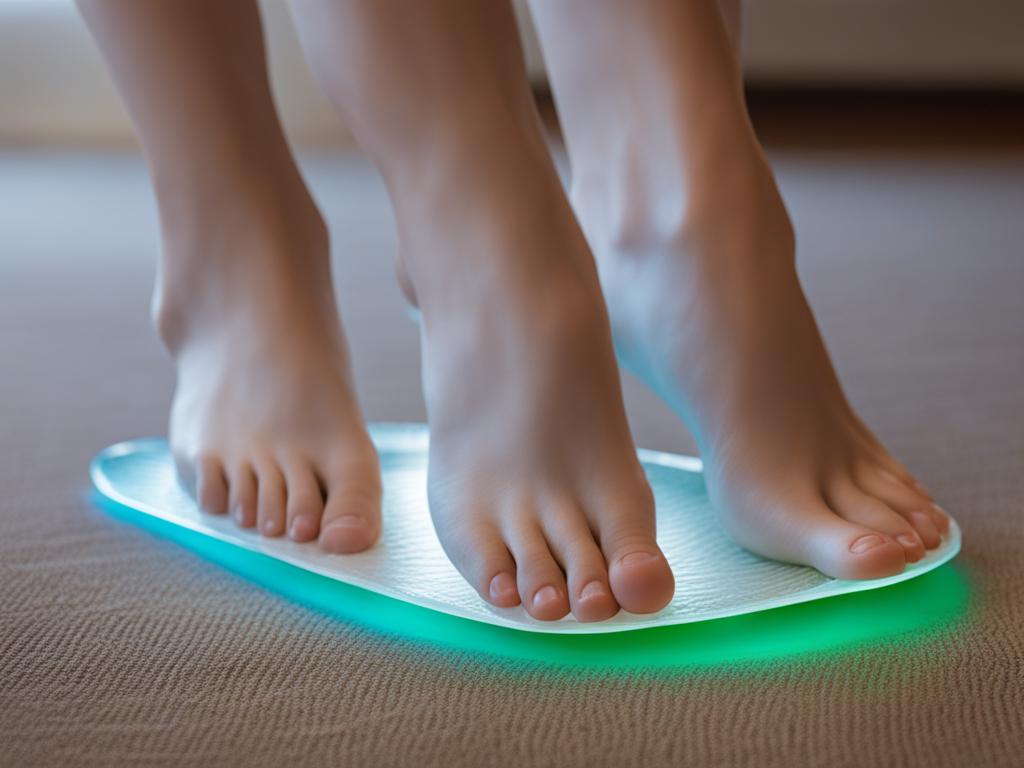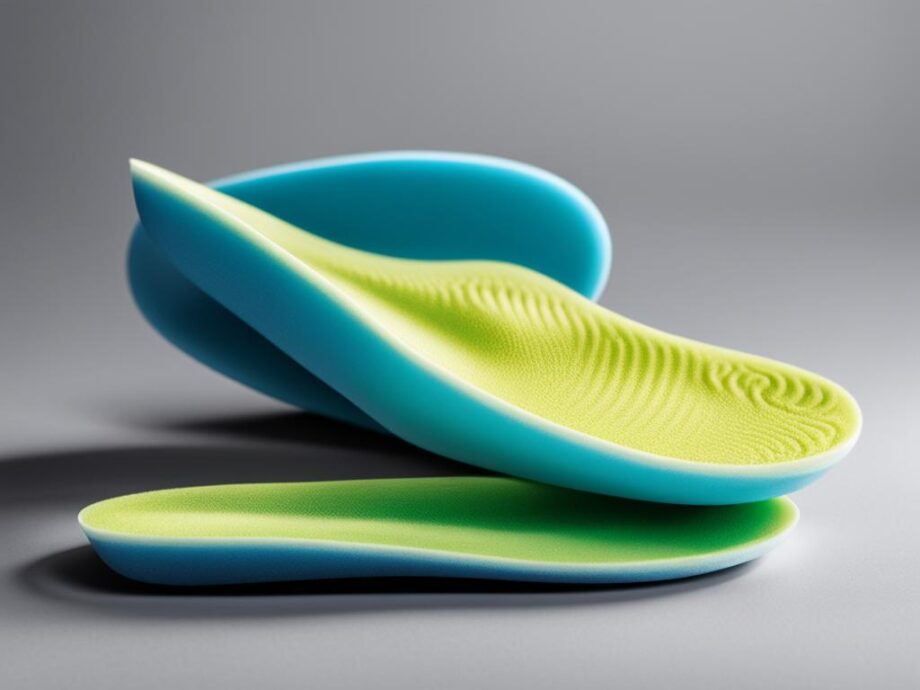Are you tired of uncomfortable shoes? Do you suffer from foot pain or discomfort? The solution to your problems might lie in the insoles you choose. In this article, we will be exploring the debate between gel and foam insoles. The battle between gel vs foam insoles has been ongoing for years, as they both provide various benefits and levels of comfort. By understanding the differences between gel and foam insoles, you can make an informed decision about which type of insole is best suited for your feet.
Key Takeaways:
- Gel and foam insoles provide different levels of comfort and support for your feet
- You should consider your individual foot conditions when choosing between gel and foam insoles
- Long-term durability and maintenance are essential factors to consider when investing in insoles
- Ultimately, the best choice between gel and foam insoles depends on your individual needs and preferences
- Choosing the right insoles can significantly improve your overall foot comfort and help alleviate foot pain or discomfort.
Understanding Gel Insoles
Gel insoles are designed for optimal comfort and support, making them a popular choice for individuals seeking relief from foot pain and discomfort. Compared to foam insoles, gel insoles offer several advantages that make them the preferred choice for many people.
The Advantages of Gel Insoles
One of the biggest advantages of gel insoles is their ability to distribute pressure evenly across the entire foot. This can help to reduce pain in areas such as the heel and ball of the foot, promoting better foot health and preventing future injuries.
In addition to pressure distribution, gel insoles also provide superior shock absorption. The gel material is able to absorb shock waves generated as you walk or run, reducing impact and minimizing strain on your joints.
Another benefit of gel insoles is their durability. The gel material is designed to withstand repeated use and retain its shape over time, ensuring long-term effectiveness and comfort.
Gel Vs Foam Insole Comparison
| Gel Insoles | Foam Insoles |
|---|---|
| Provide even pressure distribution across the foot | May cause pressure points in certain areas of the foot |
| Offer superior shock absorption | Less effective at absorbing shock waves |
| Durable and retain their shape over time | May lose shape and become less effective over time |
Table: Comparing the Advantages of Gel and Foam Insoles
Gel and Foam Insoles for Shoes
Gel and foam insoles are both designed to provide additional support and cushioning for shoes. While both provide benefits, it’s important to consider your individual needs and preferences when choosing the best insole for your shoes.
Individuals with foot conditions may prefer gel insoles for their superior pressure distribution and shock absorption. On the other hand, individuals with high arches or those who require more arch support may find foam insoles to be a better fit.
Ultimately, the best insole type depends on your personal needs and the characteristics of your shoes. Take the time to compare the benefits of both gel and foam insoles and choose the type that will provide the greatest comfort and support for you.

Image: Gel insoles provide superior shock absorption and even pressure distribution for optimal comfort and support.
Exploring Foam Insoles
Foam insoles have gained popularity over the years as they offer plenty of benefits to the wearer. One of the significant benefits of foam insoles is the cushioning they provide to the feet. These insoles are designed to absorb shock, provide extra support, and enhance overall comfort.
When compared to gel insoles, foam insoles offer better breathability, ensuring your feet stay dry throughout the day. They are also more durable, and with proper maintenance, they can last for an extended period. Additionally, foam insoles come in a wide range of densities and shapes, making them customizable to meet individual needs.
To help you understand the differences between foam and gel insoles, we have created a comparison table:
| Foam Insoles | Gel Insoles | |
|---|---|---|
| Materials | Made of lightweight foam material | Made of a soft, gel-like material |
| Cushioning | Provides excellent cushioning and shock absorption | Provides superior cushioning and shock absorption |
| Maintenance | Easy to clean and maintain | Requires careful cleaning and maintenance |
| Durability | Long-lasting with proper care | Less durable and requires replacement more often |
Overall, foam insoles are an excellent choice for those seeking cushioned support with superior breathability. They are durable, customizable, and provide reliable cushioning to your feet. When choosing between foam and gel insoles, understanding your specific needs and preferences is crucial in making the right decision.
Support and Cushioning: Gel vs Foam
When it comes to choosing insoles, the support and cushioning they provide are crucial factors to consider. Gel and foam insoles both offer unique benefits that cater to different foot needs. Here, we compare the support and cushioning provided by gel and foam insoles, to help you choose the perfect insole for your feet.

Gel Insoles
Gel insoles provide targeted cushioning, which is ideal for individuals with sensitive or painful pressure points in the feet. The cushioning effect helps reduce discomfort and absorbs shock, making them perfect for high-impact activities. They conform to the foot shape, ensuring a custom fit that provides stability and support.
Foam Insoles
Foam insoles are known for their even weight distribution, ensuring uniform support to the feet. They provide excellent cushioning, which makes them ideal for absorbing shock and providing comfort during long periods of standing or walking. Also, foam insoles are perfect for people with flat feet, as they provide the necessary arch support.
| Gel Insoles | Foam Insoles | |
|---|---|---|
| Comfort | Targeted cushioning | Even weight distribution |
| Support | Conforms to the foot shape | Arch support |
| Durability | Durable, but may require extra care | Highly durable, with low maintenance |
| Best for | High-impact activities, sensitive pressure points | Flat feet, cushioning during long periods of standing/walking |
As seen in the table above, both gel and foam insoles have their unique features. While gel insoles offer targeted cushioning and conform to the foot shape, foam insoles provide even weight distribution and arch support. It ultimately comes down to your individual needs and preferences.
Choosing Between Gel and Foam Inserts
Now that you understand the differences in comfort, support, and cushioning between gel and foam insoles, you may wonder which type of insert is better for you. The right choice depends on your specific needs, such as the type and duration of footwear usage, foot shape and size, level of physical activity, and personal preference.
If you prioritize comfort and support over everything else, gel inserts are the way to go. They offer superior cushioning and shock absorption, making them an excellent choice for high-impact activities like running or jumping. Gel inserts also tend to last longer than foam inserts, making them a cost-effective option.
On the other hand, if you are looking for a more budget-friendly option that still offers reasonable support and cushioning, foam inserts may be a better choice. They are generally softer and less bulky than gel inserts, making them ideal for casual and everyday footwear.
Comparison Chart: Gel vs Foam Inserts

| Feature | Gel Inserts | Foam Inserts |
|---|---|---|
| Cushioning | Superior | Good |
| Support | Excellent | Reasonable |
| Durability | Long-lasting | Less durable |
| Cost | Higher | Lower |
| Foot Type | High arches, plantar fasciitis, metatarsalgia | Flat feet, low arches, heel spurs |
Note: The comparison chart is meant to provide a general overview of the main differences between gel and foam inserts, but not an exhaustive list of all features and brands. Always consider your individual needs and preferences when making a purchasing decision.
In conclusion, choosing between gel and foam inserts ultimately boils down to your personal preference and the intended use of your footwear. Gel inserts may be costlier but offer superior cushioning and durability, while foam inserts may be more budget-friendly and ideal for casual wear. Consider your foot type and condition, level of physical activity, and other factors before making your decision.
Considering Individual Foot Conditions
Choosing between gel and foam insoles largely depends on individual foot conditions. Foot conditions vary from one person to another, and it’s crucial to choose an insole that caters to your needs.
For individuals with flat feet, gel insoles may be the best option as they provide maximum support and comfort. Conversely, foam insoles can be ideal for people with high arches as they can help distribute the body’s weight evenly, reducing pressure on the feet.
When choosing an insole, it’s important to consider your foot type, arch type, and any other specific conditions you may have. With the right insole, you can reduce strain on your feet, providing maximum comfort, and minimizing the risk of injury.
Ultimately, regardless of whether you choose gel or foam insoles, it’s crucial to prioritize your individual foot health and comfort. Selecting the right insole can go a long way in preventing foot conditions such as plantar fasciitis and providing an overall improved walking experience.
Long-Term Durability and Maintenance
When deciding between gel and foam insoles, it’s crucial to consider the long-term durability and maintenance of your chosen inserts. Both gel and foam insoles need proper care to ensure that they provide maximum comfort and support for an extended period.
Gel insoles are typically more durable than foam insoles. The gel material is resistant to wear and tear, making it a great long-term investment. However, gel insoles require regular cleaning to prevent the accumulation of dirt and bacteria. To clean your gel insoles, gently wipe them down with a damp cloth and mild soap. Avoid using harsh chemicals or abrasive materials that could damage the surface of the insoles.
Foam insoles, on the other hand, are less durable than gel insoles and may need to be replaced more frequently. However, foam insoles are often less expensive and can be a practical choice for individuals on a budget. Foam insoles are also very easy to maintain, requiring only occasional cleaning with mild soap and water.
Ultimately, the long-term durability and maintenance requirements of your insoles will depend on your individual needs and usage. If you are looking for a long-lasting and resilient option, gel insoles may be the way to go. However, if you prioritize affordability and ease of maintenance, foam insoles may be a better fit.
“Properly caring for your insoles can ensure that they provide maximum comfort and support for an extended period.”
Conclusion
After exploring the differences between gel and foam insoles, it’s clear that both offer unique benefits. While gel insoles provide superior cushioning, foam insoles are more affordable and suitable for everyday use.
When choosing between gel and foam inserts, it’s essential to consider factors such as foot conditions and long-term durability. Individuals with flat feet may find gel insoles more supportive, while those with high arches may prefer foam insoles.
Ultimately, the best choice depends on your individual needs and preferences. By weighing the advantages and drawbacks of each type, you can make an informed decision. Whether you prioritize cushioning, support, or affordability, both gel and foam insoles are effective options for enhancing foot comfort.
Thank you for reading this article on gel vs foam cushioning. We hope the gel and foam insole comparison has helped you choose between gel and foam inserts. Don’t forget to consider individual foot conditions before making your final decision. Choosing between gel and foam inserts doesn’t have to be a daunting task!
FAQ
What are the differences between gel and foam insoles?
Gel insoles and foam insoles have distinct properties. Gel insoles are made of a unique gel material that provides excellent shock absorption and cushioning, while foam insoles are typically made of various types of foam that offer versatility and contouring support.
What are the advantages of gel insoles over foam insoles?
Gel insoles offer superior shock absorption, providing advanced comfort and reducing discomfort caused by impact. They also have excellent energy return and can effectively distribute pressure across the foot, reducing strain and fatigue.
What are the benefits of foam insoles?
Foam insoles are known for their flexibility and ability to mold to the shape of the foot, providing customized support. They are lightweight, breathable, and offer good cushioning. Foam insoles can also help alleviate discomfort associated with flat feet or high arches.
Which type of insole provides better support and cushioning, gel or foam?
Both gel and foam insoles offer support and cushioning, but the level of support and cushioning may vary. Gel insoles provide exceptional shock absorption, making them suitable for high-impact activities. Foam insoles, on the other hand, offer versatile support and contouring capabilities, adapting to the foot’s shape and providing targeted cushioning.
How do I choose between gel and foam inserts?
When choosing between gel and foam inserts, consider your specific needs and preferences. If you require maximum shock absorption and energy return, gel inserts may be the ideal choice. If you prefer a customized fit and support that molds to your foot, foam inserts could be the better option. Assessing your activities and foot conditions can also help guide your decision.
How do foot conditions impact the choice between gel and foam insoles?
Foot conditions play a role in determining the best insole type for your needs. For individuals with flat feet, gel insoles can provide much-needed arch support and stability. Those with high arches may benefit from the contouring and cushioning capabilities of foam insoles. Understanding your foot condition will guide you towards the appropriate choice.
What should I consider regarding the long-term durability and maintenance of gel and foam insoles?
Gel insoles are known for their durability and can often withstand regular use without losing their cushioning properties. Foam insoles may require replacement more frequently due to potential compression and wear. Maintenance typically involves simple cleaning and allowing the insoles to air dry. Taking care of your insoles will help ensure their longevity.
